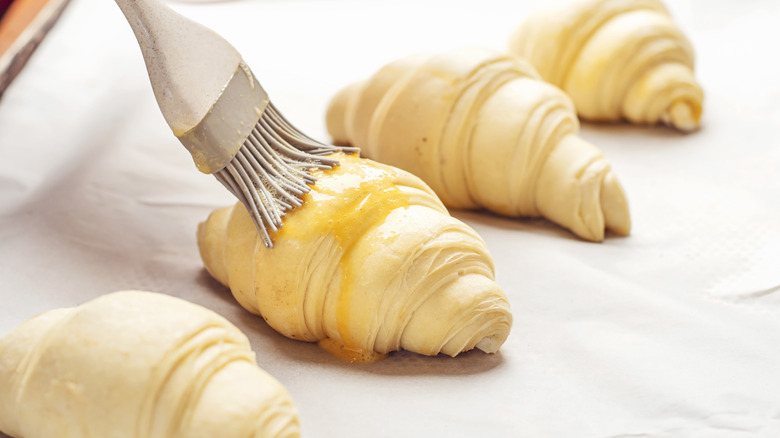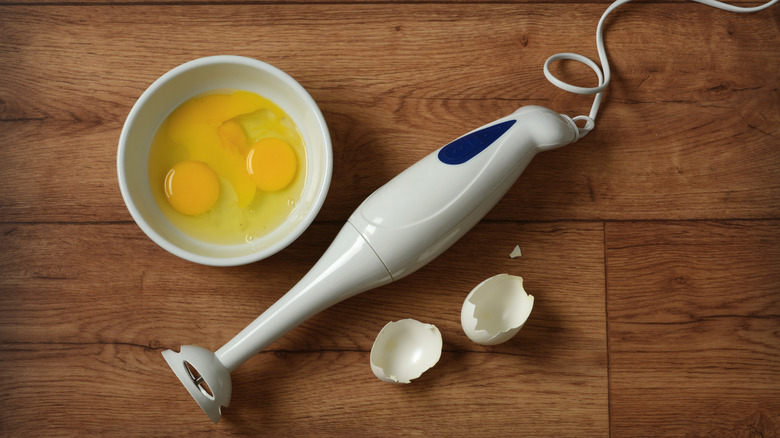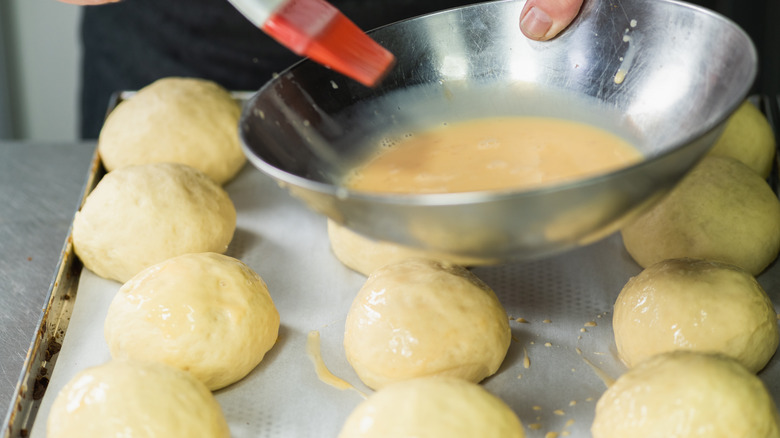Your Immersion Blender Is The Key To A Perfect Egg Wash
Your basic egg wash is a combination of two ingredients: Eggs and liquid. Making an egg wash is a relatively easy endeavor as far as kitchen projects go. Simply combine raw eggs with milk, cream, or water into a new ingredient that has multiple uses in cooking and baking, from adding a shiny glaze to dinner rolls to helping breadcrumbs stick to chicken. Although you can make an egg wash with a whisk or a fork, the best way to create a perfect egg wash is to use an immersion blender.
The key to making a proper egg wash is to make sure the ingredients are thoroughly blended. A clumpy, streaky egg wash means your final product won't have a uniform shine, and your chicken tenders won't be evenly breaded. An immersion blender is designed for small blending jobs such as this, so it's ideal for easily and effectively blending eggs and liquid into a consistently reliable ingredient.
Immersion blenders and their uses
An immersion blender, also called a "stick" blender, is a handheld tool that performs many of the same functions of a classic blender, in a compact format with variable speeds. Its size and portability allow you to use the appliance in just about any vessel, from pots and mixing bowls to jars with a mouth wide enough to accommodate the head of an immersion blender. You can even blend or chop small amounts of food with one.
In the case of egg wash, the fast bladed of an immersion blender can more effectively and evenly whip yolks and egg whites than can the tines of a fork or a standard whisk, before adding the liquid. Because an immersion blender can mix the ingredients so quickly and thoroughly, the risk of ending up with a streaky or clumpy egg wash is almost nil. Although vigorously whipping your egg wash is part of the process, be cautious — particularly with a wash using only egg whites — to not work it into a foam like the kind that's perfect for a classic frothy cocktail. You can create a terrific egg froth with an immersion blender, but that texture isn't what you want in an egg wash.
Immersion blenders can be used for a variety of other kitchen tasks, from emulsifying salad dressings to blending soups, making individual smoothies, chopping nuts and vegetables, and creating creamy purees and dips like easy homemade guacamole or even homemade mayonnaise.
Applying egg wash
An egg wash brings a shine to the surface of baked foods from sweet treats to savory breads, and acts as a natural glue for embellishments such as sesame or poppy seeds on burger buns, or pearl sugar on pastries. An egg wash also works as a seal for seams on foods like hand pies and filled pasta like ravioli. Egg wash helps breading adhere to cutlets, chicken, or breaded vegetables; and creates an enhanced golden exterior on a chicken. A well-blended egg wash is important for consistency; when applying, if some spots have a heavier amount of wash, they may also brown faster or even burn. In general, a thin coat of egg wash is the best practice.
If you are avoiding eggs, you can use your immersion blender to make egg wash alternatives with foods you may already have in your fridge, such as yogurt thinned with a bit of water, and you can get the look of an egg wash if you simply use milk, or even oil and water. There are many vegan options for egg wash too, including aquafaba and coconut oil. which adds a bit of flavor. Whatever type of wash you make, an immersion blender will help you create a perfectly homogenous mixture.


